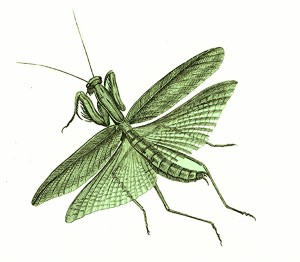Did I See an Undescribed Species of Giant Praying Mantis in South Africa?
Posted by: Karl Shuker on April 8th, 2014
About Karl Shuker
My name is Dr Karl P.N. Shuker. I am a zoologist (BSc & PhD), media consultant, and the author of 25 books and hundreds of articles, specialising in cryptozoology and animal mythology. I have a BSc (Honours) degree in pure zoology from the University of Leeds (U.K.), and a PhD in zoology and comparative physiology from the University of Birmingham (U.K.).
I have acted jointly as consultant and major contributor to three multi-author volumes on cryptozoology and other mysterious phenomena.
I am the Life Sciences Consultant to The Guinness Book of Records/Guinness World Records (Guinness: London, 1997-present day), and was consultant to Monsters (Lorenz Books: London, 2001), as well as a contributor to Mysteries of the Deep (Llewellyn: St Paul, 1998), Guinness Amazing Future (Guinness: London, 1999), The Earth (Channel 4 Books: London, 2000), and Chambers Dictionary of the Unexplained (Chambers: London, 2007).
I appear regularly on television & radio, was a consultant for the Discovery TV series Into the Unknown, and a question setter for the BBC's quiz show Mastermind.
I am a Scientific Fellow of the Zoological Society of London, a Fellow of the Royal Entomological Society, a Member of the Society of Authors, and the Cryptozoology Consultant for the Centre for Fortean Zoology (CFZ).
I have written articles for numerous publications, including Fortean Times, The X Factor, Paranormal Magazine, FATE, Strange Magazine, Prediction, Beyond, Uri Geller's Encounters, Phenomena, Alien Encounters, Wild About Animals, All About Cats, All About Dogs, Cat World, etc.
In 2005, I was honoured by the naming of a new species of loriciferan invertebrate after me - Pliciloricus shukeri.











I don’t know, Karl. DID YOU? I am sick of this kind of report; no specimen or actual insect is in evidence. We are asked to accept this BS as some sort of “proof”?
I am thoroughly disgusted with this type of “report”, which reports nothing, but begs for belief.
Interesting…
The major reason why we had giant arthropods in the Carboniferous period is that there was a lot more oxygen in the atmosphere: you jam pakc an atmosphere with oxygen, and you get bigger arthropods. Their breathing systems make gigantism in our world hard to come by, but in the carboniferous period there were Dragonflies the size of eagles (Meganuera) and giant millipede like beasts (Anthropleura). If a giant Preying Mantis lives today, I doubt it would be truly super-colossal, but I wouldn’t rule out one a bit bigger than any known today.
@Goodfoot – Of course no actual insect or specimen is in evidence – if it was, it wouldn’t be cryptozoological, would it?? As soon as a specimen of any mystery animal is obtained and is made available for formal scientific examination, by definition it ceases to be cryptozoological and becomes mainstream zoological. If you cannot grasp that basic tenet of cryptozoology, I have to wonder what on earth you are doing commenting on a cryptozoological website! After all, by your definition of what constitutes a worthy cryptozoological report, no eyewitness report of any kind would be acceptable, so pretty well every report on here and other crypto websites would be discounted out of hand.
In any case, I wasn’t asking anyone to accept my sighting as proof – I was asking for a possible identification of its species, as I am no mantis specialist and readily concede that it may belong to a known species that I am unaware of, despite having researched the matter myself.